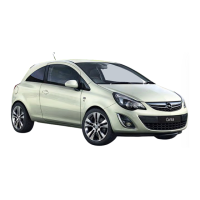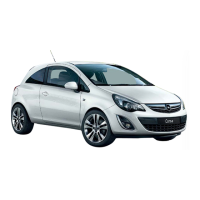Do you have a question about the Opel CORSA 1.4 2019 and is the answer not in the manual?
Explanation of danger, warning, and caution symbols and their implications for safety.
Instructions on how to fasten and unfasten the seat belt correctly for safety.
Diagram and identification of key components on the vehicle's instrument panel.
Controls for temperature, fan speed, air distribution, cooling, and air recirculation.
Instructions for operating manual transmission, including gear selection and clutch use.
Explanation of automatic transmission modes (P, R, N, D, M) and selector lever operation.
Safety warnings and procedures for parking the vehicle on different surfaces and slopes.
Details on opening and closing doors, including load compartment and tailgate operations.
Information on anti-theft locking systems, alarm systems, and immobilisers.
Information on windscreen stickers, replacement, manual, and power windows.
Important safety warning regarding the use of child locks for rear seats.
Activating and deactivating the anti-theft locking system, including warnings.
How the alarm system monitors doors, tailgate, bonnet, and ignition.
Details on adjusting seat position, including longitudinal, backrest, and height adjustments.
Detailed guide on adjusting seat position, including longitudinal, backrest, and height.
Proper use, reminder system, and maintenance of seat belts for occupant safety.
Fastening and using a three-point seat belt correctly, including sport seat variations.
Explanation of front, side, and curtain airbag systems, including warnings and deactivation.
Description of front airbags in steering wheel and passenger panel, and their activation.
Explanation of side airbags in seat backrests and their activation in side impacts.
Details on curtain airbags in the roof frame and their activation in side-on impacts.
How to deactivate the front passenger airbag for child restraint systems.
Safety warnings for using child restraints with active airbags and recommendations for systems.
Safety warnings for using child restraints with active airbags and recommendations for systems.
How to fit ISOFIX child restraint systems to mounting brackets on rear and front seats.
Permissible options for fastening child restraints with three-point seat belts and ISOFIX systems.
Instructions for extending the load compartment by folding rear backrests.
Operation of windscreen wipers, adjustable interval, and automatic rain sensor sensitivity.
Overview of warning lights, gauges, and indicators in the instrument cluster and centre console.
Displays fuel level or gas content, with low fuel indication and arrow for fuel filler flap location.
Switching between petrol and liquid gas operation, LED status, and fuel mode storage.
How the LED display indicates coolant temperature, with warnings for overheating.
Engine oil life system for oil and filter change indication, and displaying remaining oil life.
Explanation of control indicators, their colours, and meanings for vehicle status and warnings.
Overview of control indicators located in the instrument cluster.
Meaning of the red airbag indicator, fault detection, and deployment indication.
Yellow indicator for emission control system faults and catalytic converter damage.
Yellow indicator and message for required vehicle service.
Yellow indicator for ABS system readiness, faults, and regulation process.
Green or yellow indicator for system status and unintended lane changes.
Yellow indicator for system engagement, faults, and operation.
Yellow indicator for exhaust filter cleaning required or filter full status.
Yellow indicator for tyre pressure loss, system faults, and sensor issues.
Red indicator for low engine oil pressure.
Yellow indicator or flashes for low fuel level and refueling needs.
White or green indicator for system status and activation.
Green indicator when a vehicle ahead is detected in the same lane.
Indicator in Driver Information Centre when speed limiter is active.
Display of detected traffic signs as a control indicator.
Overview of the Driver Information Centre, its versions, and the information it provides.
Location, versions, and indications provided by the Driver Information Centre.
Messages indicated in the Driver Information Centre, often with a warning chime.
Personalizing vehicle behaviour by changing settings in the Info Display.
Settings for climate, comfort, parking assist, exterior lighting, door locks, and remote functions.
Activating/deactivating rear view camera guidelines and parking assist symbols.
OnStar services: emergency support, Wi-Fi hotspot, smartphone app, remote control, stolen vehicle assistance.
General and emergency services provided by OnStar, including Wi-Fi hotspot functionality.
Using myOpel smartphone app for remote vehicle functions like lock/unlock, honk, and fuel level check.
Operation of the light switch for headlights, sidelights, and lights off.
Controls for temperature, fan speed, air distribution, cooling, and air recirculation.
Steps to demist and defrost windows using temperature, fan speed, and air distribution controls.
Procedure for demisting/defrosting, including automatic settings and return to previous mode.
Operation of electronic climate control system, including fan speed, temperature, and air distribution.
Procedures for starting the engine and initial operation, including running-in and ignition positions.
Procedure for starting the engine using the ignition key, including manual and automatic transmission steps.
How the stop-start system saves fuel and reduces emissions by switching off the engine.
Danger of engine exhaust gases and precautions for preventing entry into the vehicle.
Automatic and manual cleaning processes for the exhaust filter, and indicator lights.
Permits automatic or manual gearshifting, with selector lever operation and transmission display.
Explanation of brake system, circuits, and effect when engine is not running.
How ABS prevents wheel locking and maintains steerability during braking.
Operation of the manual parking brake, including warnings and reduction of operating forces.
Traction Control and Electronic Stability Control systems for improving driving stability.
How TC improves stability by preventing drive wheels from spinning.
How ESC improves stability by reducing engine output and braking wheels during swerving.
Feature for increased steering assistance in city traffic or parking.
Systems designed to support the driver, but not replace attention.
How to store and maintain speeds, with activation conditions and deactivation.
Prevents exceeding a preset maximum speed, with activation and change functions.
System to help avoid or reduce harm from front-end crashes using a front camera.
Rear and front-rear parking assist systems using ultrasonic sensors and acoustic signals.
Assists driver when reversing by displaying area behind the vehicle in Colour Info Display.
Detects and displays designated traffic signs via a front camera in the Driver Information Centre.
System observing lane markings to warn driver of unintended lane changes.
Information on fuel types, octane ratings, and recommended specifications for petrol engines.
Information on LPG (Autogas), its composition, octane rating, and storage.
Performing work and checks in the engine compartment, with safety warnings.
Safety warnings for performing engine compartment checks when the ignition is off.
Information on coolant properties, freeze protection, and approved antifreeze.
Information on brake lining wear, squealing noises, and the effect of new brake linings.
Maintenance-free battery, avoiding discharge, and disconnecting/reconnecting procedures.
Danger warning about Xenon headlights' high voltage and bulb replacement by workshop.
Information on fuses, fuse boxes, and fuse extractor.
Data on replacement fuses, fuse box locations, and identifying blown fuses.
Information on tyre condition, designations, winter tyres, and wheel covers.
Checking cold tyre pressure regularly, not forgetting the spare wheel.
How the system checks tyre pressure and warns of low pressure conditions.
Procedure for jump starting a vehicle with a discharged battery using jump leads.
Instructions for towing the vehicle and towing another vehicle.
Using only products that meet recommended specifications, with warnings on hazardous materials.
Using only products that meet recommended specifications, with warnings on hazardous materials.
Engine oil quality and viscosity, Dexos, and ACEA specifications for petrol engines.
Using silicate-free long life coolant antifreeze, and factory-filled concentrations.
Recommended fluids and lubricants based on European service schedule and ambient temperature.
Recommended engine oil quality and viscosity grades based on ambient temperature.
Table of engine data including identifier code, sales designation, piston displacement, power, torque, and fuel type.
Tyre pressure tables for different engines, loads, and comfort settings.
Information about data processing in the vehicle, including event data recorders and privacy.
| Brand | Opel |
|---|---|
| Model | CORSA 1.4 2019 |
| Category | Automobile |
| Language | English |











